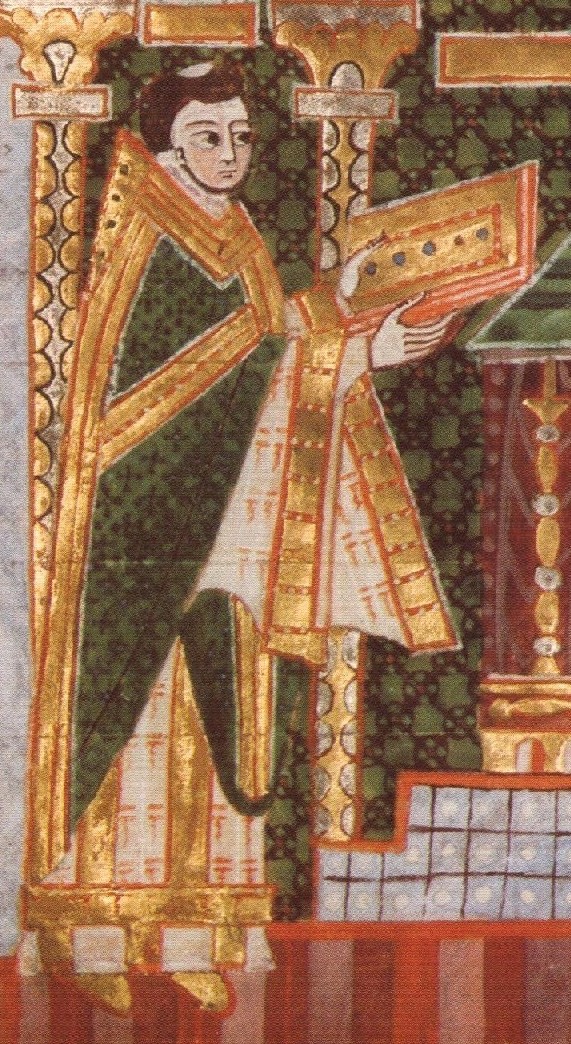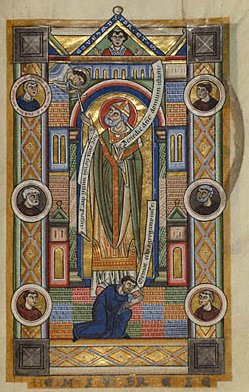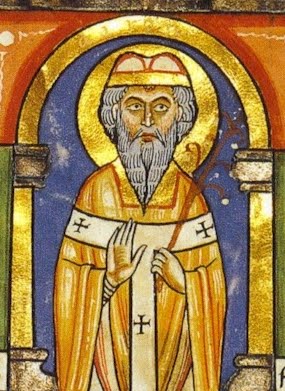Bernward of Hildesheim
Bernward of Hildesheim (c. 950/960; † November 20, 1022 in Hildesheim ) was Bishop of Hildesheim 993-1022 and is a saint of the Catholic Church. Also in the Evangelical Church in Germany, he is considered memorable witness to the faith. Bernward means Old High German guards in front of the bear.
Life and work
Bernward came from the Saxon nobility. Who was his father, is uncertain; maybe it was Margrave Dietrich of the Nordmark († 985 ) or Count Palatine Dietrich I of Saxony († 995 ). He spent his childhood his mother with his grandfather, the Count Palatine of Saxony Adalbero until his death.
In the Hildesheim cathedral school he had received a comprehensive education. In the year 977 it most likely led his uncle Folcmar - formerly Chancellor of Emperor Otto II, since 976 Bishop of Utrecht - at court and had him trained as a notary. Since 987 he was at the court of the Empress Theophano, who held the regency after the death of Otto II, author and writer of rulers certificates. From 987/988-993, he was a teacher of King Otto III. active. Important already is his participation as a priest Bernward in 983 at the meeting of the sizes of Saxony in the Hesleburg (ad civitatum Hesleburg, according Thietmar of Merseburg ) in Burgdorf ( Wolfenbüttel ).
On January 15, 993 Bernward was ordained by Willigis, the competent Archbishop of Mainz, bishop. His tenure in the era of the Saxon emperors who had their family roots in hinterland of Hildesheim and were associated with Bernward personally. In this time of Hildesheim was one of the power centers of the empire, and Bernward was determined to give this a meaning appropriate face of his city after the model of Rome. Most famous evidence of this endeavor are the Bernward doors of the Hildesheim Cathedral ( bronze castings with scenes of the history of salvation according to the model of the wooden doors of Santa Sabina in Rome), the Christ column ( cast bronze with painted frieze of the works of Christ, following the example of the stone imperial columns in Rome ) and the massive building the early Romanesque St. Michael's Church ( completed after Bernward death), which was built in the image of the heavenly Jerusalem, and at the same time as his burial church of the bishop. This bernwardinischen art treasures are now on the UNESCO list of world cultural heritage.
For his sister, the abbess of Judith Ringelsheim, Bernward donated the merry- Heimer Cross, a monumental wooden sculpture of the crucified Christ, which marks with only a few comparable works the resumption of sculpture art in the West.
Bernward built the Cathedral precinct with a strong zwölftürmigen wall (partially preserved) to Domburg and designed in a country other castles to defend against the neighboring Slavic tribes. But also the inner spiritual life of his diocese and the poor relief to his heart. In his will, which is dated to the year 996, Bernward bequeathed a private church in Burgstemmen the Chapel of the Cross of St. Michael monastery in Hildesheim.
On Michaelmas Day (29 September ) of the year 1022 Bernward consecrated the unfinished abbey church of St. Michael. On Martinmas (November 11 ) of the same year he became a monk of this Benedictine monastery, where he died on 20 November 1022. After his death he was buried in the crypt of St. Michael's Church. His life was written by his teacher Thangmar in the Vita Bernwardi. At least for parts of the authorship is guaranteed - other parts were probably added in the high Middle Ages. Bernward died a few weeks after the consecration of St. Michael. His sarcophagus built by him in the St. Michael's Church in Hildesheim is empty, the relics rest in the Church of the Madeleine. A first attempt of a bishop's canonization in 1150 failed and was finally able to obtain cardinal Cinthius 1192 Bernward's canonization.
Effect
Bernward was by Pope Celestine III. ( Pope 1191-1198 ) canonized. In this case, an earlier as a saint is occupied already by the liturgical Ratmann Sacramentary ( 1159 ) and the Stammheimer Missal in Michaeliskloster. His Protestant and Roman Catholic feast day is November 20, its attributes are episcopal vestments, church model and in particular the Bernward Cross. In the Walhalla Donaustauf is to his memory even before 1847 a plaque was erected. On the Hildesheim Domhof is the Bernward monument since 1893. In the diocese of Hildesheim carry many churches, especially from the 18th and 20th centuries, its name (see Bernward church).
Bernwardinische art
- Bernward Cross
- Bernwardpsalter
- Bernward's door
- Christ pillar (Hildesheim )
- St. Michael (Hildesheim )
Swell
- Thangmar: Vita Bernwardi episcopi Hildesheimensis. In: Georg Heinrich Pertz et al (eds): Scriptores ( in folio ) 4: Annales, chronica et historiae aevi Carolini et Saxonici. Hannover 1841, pp. 754-782 ( Monumenta Historica Germaniae, digitized ).
- Life of St. Bernward, Bishop of Hildesheim, written by Thangmar, in (?): Biographies of some bishops of the 10th - 12th Century, translated by Hatto Kallfelz. ( Selected sources on German history of the Middle Ages 22), Darmstadt 1973, p 263-361.
- Thietmar of Merseburg Chronicle. Translated by Werner Trillmich. ( Freiherr vom Stein Memorial Issue 9 ), Darmstadt 1957 Latin Text in Robert Holtzmann (ed.). Scriptores rerum Germanicarum, Nova series 9: The Chronicle of the Bishop Thietmar of Merseburg and their Korveier revision ( Thietmari Merseburgensis episcopi Chronicon ) Berlin 1935 ( Monumenta Historica Germaniae, digitized )









